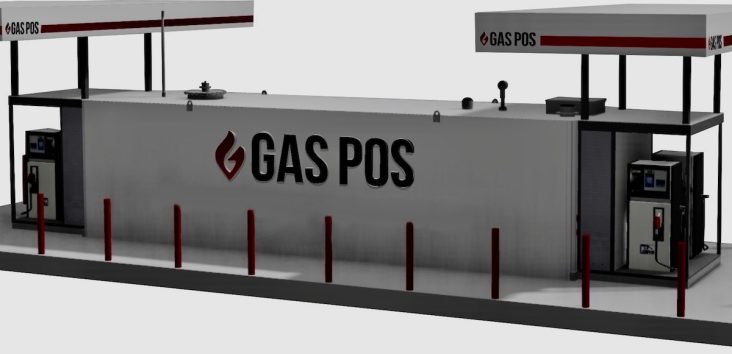Gas Pos, AMS to open portable gas stations in 22 states
by June 8, 2022 10:30 am 3,113 views

North Little Rock-based fintech Gas Pos and AMS Technologies of Oceanside, N.Y., have partnered to open portable, aboveground gas stations (PAGS) across the United States that can open more quickly and at a lower cost than stations with underground storage tanks.
Joshua Smith, CEO of Gas Pos, said only one portable aboveground gas station is open in the United States, and Gas Pos provides the point-of-sale technology for it. The companies are working to receive approval to open the gas stations in 22 states. Five Arkansas locations are in the works, including in Little Rock, Bryant, Searcy and Hot Springs, according to a Wednesday (June 8) press release from the companies.
“AMS has worked to create opportunities for installations across the country and understands the codes PAGS are designed to embrace; whereas Gas Pos has a network of locations and an industry know-how that leans into more to rapidly moving PAGS across the finish line for end-users,” said Ethan Henderson, director of operations for AMS. “Gas Pos is the catalyst to drive this industry shift to the finish line.”
The systems are manufactured at three facilities domestically and internationally in Mexico and China. Components are sourced in the United States for the portable, above ground gas stations (PAGS). Gas Pos has about 50 employees.
According to the release, AMS owns the exclusive U.S. retail rights to portable, aboveground fueling stations that are approved by the U.S. Environmental Protection Agency, National Fire Protection Association and UL.
Smith said up to 90% of the nearly 180,000 fueling systems in North America may violate underground tank storage covenants. He pointed to a 1999 regulatory change requiring all underground tanks for petroleum products or other hazardous waste must have two walls to prevent leaking.
The average cost to replace pumps, tanks and accessories is $200,000 to $300,000, according to Ron Sickels of Accredited Fuel Solutions Inc. He said the changes can take months compared to weeks for an aboveground storage tank system.
“This doesn’t take into consideration the environmental impact that underground storage tanks put on the owner, station location and the ongoing maintenance necessary to stay compliant with the local, state and federal regulatory agencies,” Sickels said. “If the location has the necessary footprint to accommodate an (aboveground storage tank) system utilizing the latest environmentally-compliant storage, infrastructure and dispensing system, you will produce a station that is easier to maintain, environmentally safer and less costly to install and operate.”
The release shows that opening a portable, aboveground gas station “can be done for 80% less than the cost of digging everything out and dropping in new underground tanks.” Sickels said the average cost “is in the millions” for a gas station with four gas dispensers, underground tanks, concrete footings, piping and spill buckets. The release shows this type of station typically takes about 10 months to build. Meanwhile, a portable, aboveground gas station can be completed more quickly and at about one-third of the cost of a traditional gas station.
“Both gas station owners and consumers are suffering right now,” Smith said. “Store owners often can’t afford to upgrade, leading the state to red tag the station or outright shut them down. In a world where fuel supplies are already limited and gas prices are skyrocketing, taking supply off the market only exacerbates our problems. We’re here to help both owners and consumers.”
Henderson noted a Nevada town, which was built on a large aquifer, didn’t want to risk contamination from an underground fuel system. However, the town council approved a portable, aboveground gas station because the technology met all environmental regulations.
“We seized on a regulatory change in 2008 that allowed for the development and patenting of several technologies around PAGS innovations,” Henderson said. “It meets UL, ANSI and other regulations – and then some. The testing process is rigorous for the PAGS UL2085 rating, with tests including two hours in a 2,000-degree furnace, 12,000 pounds per square inch impact testing and ballistics testing with several high caliber rounds, all of which are performed sequentially to push success to the limit. These systems are incredibly safe, and the regulations for success ensure that.”
Henderson said he sees the portable, aboveground gas stations as a bridge to an environmentally-friendly future. He believes many station owners won’t commit to another 20 years of underground tanks at a time when electric and other ‘green’ technologies are gaining market adoption. Also, AMS has aligned itself with an electric vehicle charging manufacturer so that chargers can be installed at portable, aboveground gas stations.
“A lot of change will happen in this space over the next five to 10 years,” Henderson said. “That means this aboveground solution makes a lot more sense than continuing with underground because you just don’t know what’s coming. The track record for underground tanks, both economically and environmentally, is terrible. PAGS fixes this.”
